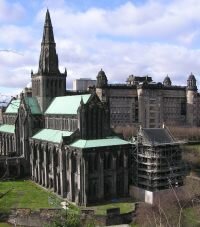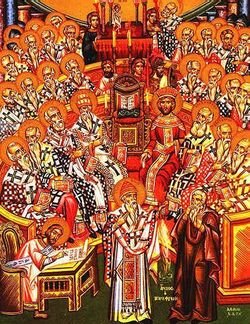Theological Dictionary word of the day: Body of Christ
The Body of Christ is a term used by Christians to describe believers in Christ. Jesus Christ is seen as the head of the body, which is seen as the church. The "members" of the body are seen as members of the Christian Church.
In the Roman Catholic tradition, the term "Body of Christ" refers most specifically to the "bread" received at the Eucharist, while the "wine" is referred to as the "Blood of Christ." It is, however, doctrinally incorrect to refer to these elements as "bread" and "wine" after the Consecration; according to Catholic doctrine, at the moment of Consecration, the elements (or "gifts" as they are termed for liturgical purposes) are transformed (literally transubstantiated) into the actual Body and Blood of Christ. Catholic doctrine holds that the elements are not only spiritually transformed, but rather are actually (substantially) transformed into the Body and Blood of Christ. The elements retain the appearance or "accidents" of bread and wine, but are indeed the actual Body and Blood of Christ. This is what is meant by Real Presence; the actual, physical presence of Jesus in the Eucharist. Other traditions accept this doctrine in various forms, often utilizing the term “consubstantiation” to refer to a spiritual change into the Body and Blood, without changing the substance of the elements. For this reason, what remains of the sacrament after the Communion procession is reserved in the Tabernacle, where it can be utilized for later Masses, for private devotion and prayer, as well as for public Eucharistic adoration.
In the context of the local churches it is a metaphor used to describe the synchronicity between different localities and God. In this, God is the head and the people who make up the Church in each locality are termed "members of the body". The "members of the body" may look different and/or may perform different functions, but they all work as one under the will of the head (God). For example, a person who is a gifted orator is encouraged to use his or her talents to act as a mouthpiece for God. Other such personal strengths would be similarly applied towards the "expression of Christ". In this way people can be functioning and active members of the "Body of Christ".
The Body of Christ, meaning the entire community of Christians, is also called the Bride of Christ, for whom Christ will return.
 A religious denomination, (also simply denomination) is a large, long-established subgroup within a religion that has existed for many years. However, in Islam such subgroups are referred to as "sects", not denominations.
A religious denomination, (also simply denomination) is a large, long-established subgroup within a religion that has existed for many years. However, in Islam such subgroups are referred to as "sects", not denominations.
 The seven churches of Asia (properly Asia Minor) are seven
The seven churches of Asia (properly Asia Minor) are seven


